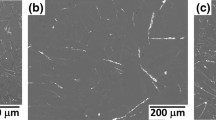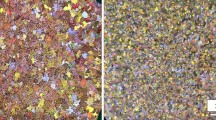Abstract
The effect of Be and Fe content on the plane strain fracture toughnessK IC of aluminum-based A357 alloys is investigated. The fracture behavior of A357 alloys has been evaluated as a function of both the magnitude and morphology of iron-bearing compounds and silicon particles. Addition of Be is beneficial for tensile properties and fracture toughness in the case of alloys containing intermediate (0.07 pct) and higher (0.15 pct) Fe levels. On the other hand, Be added to alloys containing the lower Fe (0.01 pct) level appears detrimental to tensile strength, but the quality index, notch-yield ratio (NYR), and plane strain fracture toughness were improved. Fractographic analysis reveals that crack extension of A357 alloys occurs mainly in an intergranular fracture mode. The fracture processes are initiated by void nucleation at iron-bearing compounds or irregularly shaped eutectic silicon particles as a result of their cracking and decohesion from the matrix. Then, void growth and coalescence result in growth of the main crack by shear-linkage-induced breakdown of submicronstrengthening particles. The effect of Be on increasingK IC is more apparent in the higher Fe alloys than in the lower Fe alloys. Superior toughness obtained by microstructural control has also been achieved in the intermediate and higher Fe levels of Be-containing alloys, with values equal to those obtained in alloys of lower Fe content.
Similar content being viewed by others
References
A.K. Vasudevan, R.D. Doherty, and S. Suresh:Aluminum Alloys: Contemporary Research and Applications: Treatise on Materials Science and Technology, A.K. Vasudevan and R.D. Doherty, eds., Academic Press, Inc., London, 1989, pp. 445–62.
G.T. Hahn and A.R. Rosenfleld:Metall. Trans. A, 1975, vol. 6A, pp. 653–68.
J.T. Staley:Properties Related to Fracture Toughness, ASTM STP 605, ASTM, 1976, pp. 71–103.
G.M. Ludtka and D.E. Laughlin:Metall. Trans. A, 1982, vol. 13A, pp. 411–25.
I. Kirman:Metall. Trans., 1971, vol. 2, pp. 1761–70.
H.J. Li, S. Shivkumar, X.J. Luo, and D. Apelian:Cast Met., 1989, vol. 1 (4) pp. 227–34.
S. Shivkumar, C. Keller, and D. Apelian:AFS Trans., 1990, pp. 905–11.
D.M. Jiang, B.D. Hong, and T.C. Lei:Scripta Metall., 1990, vol. 24 (4), pp. 651–54.
S. Fujuki, M. Tskuda, S. Koike, and I. Fukui:J. Jpn. Inst. Light Met., 1983, vol. 33 (12), pp. 712–18.
S. Murali, K.S. Raman, and K.S.S. Murthy:Mater. Sci. Eng. A, 1992, vol. A151, pp. 1–10.
J.G. Kaufman, G.T. Sha, R.F. Kohm, and R.J. Bucci:Cracks and Fracture, ASTM STP 601, ASTM, 1976, pp. 169–90.
Y.H. Tan, S.L. Lee, and Y.L. Lin:Metall. Mater. Trans. A, 1995, vol. 26A, pp. 0000–00.
S. Gowri:Metall. Trans. A, 1993, vol. 24A, pp. 2810–12.
O. Reiso, N. Ryum, and J. Strid:Metall. Trans. A, 1993, vol. 24A, pp. 2629–41.
M.H. Mulazimoglu, R.A.L. Drew, and J.E. Gruzelski:J. Mater. Sci. Lett., 1989, vol. 8, pp. 297–300.
Author information
Authors and Affiliations
Rights and permissions
About this article
Cite this article
Tan, YH., Lee, SL. & Lin, YL. Effects of be and fe content on plane strain fracture toughness in A357 alloys. Metall Mater Trans A 26, 2937–2945 (1995). https://doi.org/10.1007/BF02669650
Received:
Issue Date:
DOI: https://doi.org/10.1007/BF02669650




